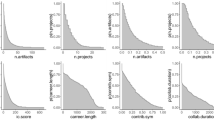Abstract
A research group is considered to be a system and the scientists the elements in this system. The degree of interaction among scientists is determined by means of a complex structure measure for groups. It is shown that optimum cooperation structures depend on group size. In addition, it was possible to determine an optimum group size. Various hypotheses have been verified employing the same data material by using several levels of the structure measure.
Similar content being viewed by others
References
J. E. COHEN, Publication rate as a function of laboratory size in a biomedical research institution.Scientometrics, 2 (1980) 35–52.
J. T. WALLMARK, S. ECKERSTEIN, B. LANGERED, H. E. S. HOLMQVIST, The increase in efficiency with size of research teams, in:IEEE Trans, Eng. Manag., Vol. EM-20, No. 3, August, 1973, pp. 80–86. These authors define efficiency as the ratio of the number of references to the team size.
M. M. QURASHI,The Mechanics of R & D and Technology Transfer, Pakistan Academy of Sciences. No. 34, Street 32, Shalimar 7/1, Islamabad
R. STANKIEWICZ,Leadership and the performance of research groups. RPI Research Policy Institute, University of Lund, 1980.
H. KRETSCHMER, Representation of a Complex Structure Measure for Social Groups and its Application to the Structure of Citations in a Journal.Scientometrics 5 (1983) 5–30.
R. D. WHITLEY, Kommunikationsnetze in der Wissenschaft. Status und Zitierungsmuster in der Tierphysiologie in: P. WEINGART, Hrsg.,Wissenschaftssoziologie II, Athenäum Fischer, Frankfurt/Main, 1974.
D. C. PELZ, F. M. ANDREWS,Scientists in Organizations, Rev. ed. Ann Arbor, Michigan, Institute for Social Research, The University of Michigan, 1976,
S. D. HAITUN,Naukometria. Sostoyanie i perspektivy, Izdatelstvo Nauka, Moscow, 1983.
H. M. SCHRODER, M. J. DRIVER, S. STREUFERT,Menschliche Informationsverarbeitung, Weinheim, Basel, 1975.
J. E. COHEN, Publication rate as a function of laboratory size in three biomedical research institutions,Scientometrics, 3 (1981) 467–487.
J. E. COHEN, Statistical Theory Aids Inference in Scientometrics,Scientrometrics, 6 (1984) 27.
M. M. QURASHI, Publication rate as a function of the laboratory/group size,Scientometrics 6 (1984) 19.
P. A. P. MORAN, Partial and multiple rank correlation,Biometrika, 38 (1951) 26–31.
P. B. SCHELISCHTSCH,Dinamika nauki, Lenignrad' Nauka', Leningradskoye otdelenija, 1981.
R.-L. WINKLER, Zu Kooperationsformen in Forschungsgruppen, Akademie der Wissenschaften der DDR. Institut für Theorie, Geschichte und Organisation der Wissenschaft,Studien und Forschungsberichte. Teil I, 1977.
Author information
Authors and Affiliations
Rights and permissions
About this article
Cite this article
Kretschmer, H. Cooperation structure, group size and productivity in research groups. Scientometrics 7, 39–53 (1985). https://doi.org/10.1007/BF02020140
Received:
Revised:
Issue Date:
DOI: https://doi.org/10.1007/BF02020140




